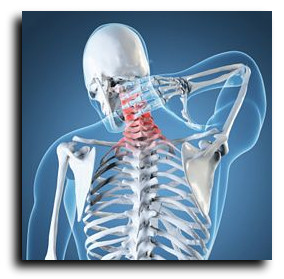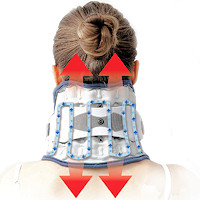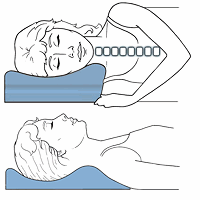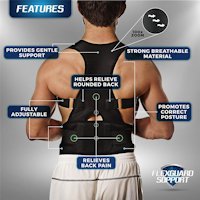Neck Disability – Online Form To Determine & Monitor Neck Related Disability
 Neck pain is a frequent problem. It will become persistent for about 30 to 50 percent of sufferers, therefore comprising one of the more significant factors associated with disability as well as work force decline. The neck disability index can give you a baseline and follow up at any time to monitor progress.
Neck pain is a frequent problem. It will become persistent for about 30 to 50 percent of sufferers, therefore comprising one of the more significant factors associated with disability as well as work force decline. The neck disability index can give you a baseline and follow up at any time to monitor progress.
Neck pain may have an effect on a person’s day to day living. Persistent or chronic neck pain leads to significantly greater medical expenses as well as reduces work capability. Therefore, it is essential to evaluate the degree of self rated neck disability and the online form is an important and consistent indicator
This set of questions is made to help comprehend just how much a person’s neck pain impacts the capability to handle every day activities. Make sure you answer each and every portion simply by selecting the 1 option which best relates to you. You might think one or more statements may well describe your situation, however make sure you only check the 1 option that best identifies your condition at this time.
Right after responding to every one of the sections, you can simply click the “Click Here For Disability Score” for disability score or index and meaning. Take note of areas that are of concern or focus to discuss with your doctor or direct in appropriate products.
This is not the original neck disability index and is simply designed to give you an idea of how your neck pain affects your life. Your doctor may use a disability index to document your initial condition, and then use it every 2 weeks or every month to monitor your progress or lack of progress. Similarly, you can use this to check your initial condition and then monitor your own progress to any type of home remedy you are doing. The idea is to compare one score to the next, over a period of time.
Neck Disability Reliability
- A 2015 study in the European Journal of Neurosurgery found the Neck Disability Index had a significant correlation to discern quality of life as well as mental health measures for patients suffering one level cervical disc disease with radiculopathy.
- A 2016 study in the European Spine Journal concluded the Index is a valid patient reported outcome measure for whiplash patients, providing reliable measurements of neck condition and appropriate for assessing related functional status.
- A 2021 study in Diagnostics found the single most accurate variable in classifying health status six months after whiplash injury was the relative change of disability index, showing the highest accuracy at 73.9% compared to diagnostic ultrasound shear wave elastography.
Usefulness
It is often better to use this index because it incorporates different factors other than just neck pain. This makes it more useful for determining response to treatments as well as factors which contribute.
- A 2008 study in Applied Ergonomics evaluated the risk factors for neck pain and disability among female office workers. The authors found mainly ergonomic factors, but psychosocial factors as well. The authors of the study concluded. “These results suggest that measuring the level of neck pain and disability rather than just the presence of neck pain provides more specific directives for the prevention and management of this disorder.
- A related 2010 study in the journal Ergonomics used the disability index as the main measure of outcomes. They found psychosocial factors at work like high supervisor support and decision authority help protect against physical risk factors like time spent on computer, poor computer monitor placement and extended periods using a mouse.
In office workers, more neck pain was associated with a combination of physical and psychosocial stressors than either factor alone. The authors concluded, “This finding has important implications for strategies aimed at the prevention of musculoskeletal problems in office workers.”
As a certified consultant in reviewing cases for both doctors and insurance companies, the report I issued carried much weight on continuation or cessation of care in any particular instance. This type of documented assessment questionnaire, instituted on a regular basis (at least monthly), played a major role in documenting the appropriateness of care, when combined with evidence and consensus based literature.
Neck Pain Help
- A 2021 study in the International Journal of Occupational Safety and Ergonomics indicated significant risk factors for neck disability in office workers are female gender, high body mass index, work experience grater than 10 years daily computer usage time greater than 8 hours, the monitor’s position located outside the midline, and stress levels. The authors concluded, “This information may enable designing appropriate workstations for preventing neck disability and prevent labor losses.”


 Neck Traction Devices
Neck Traction Devices Cervical Pillows
Cervical Pillows Neck Support Collars
Neck Support Collars Muscle Therapy Tools
Muscle Therapy Tools Head Supports
Head Supports Topical Pain Relievers
Topical Pain Relievers Special Pillows
Special Pillows Heat Therapy
Heat Therapy Cold Therapy
Cold Therapy TENS Therapy
TENS Therapy Posture Braces
Posture Braces Neck Stabilization
Neck Stabilization Ergonomic Aids
Ergonomic Aids New Mattresses
New Mattresses Relief Supplements
Relief Supplements